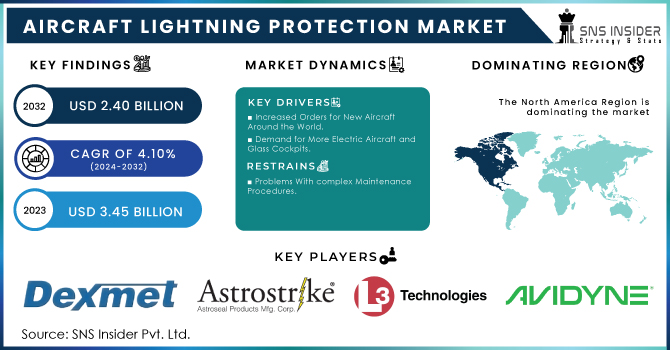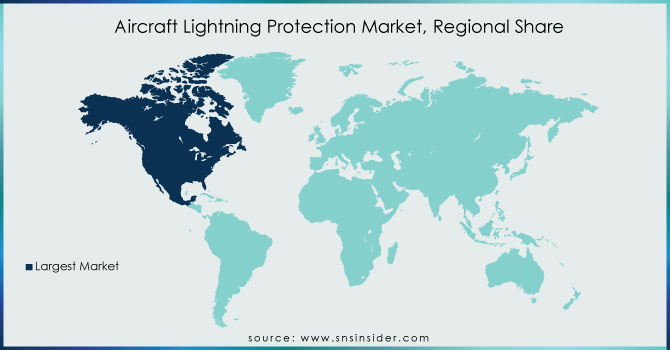Aircraft Lightning Protection Market Report Scope & Overview:

To get more information on Aircraft Lightning Protection Market - Request Free Sample Report
The Aircraft Lightning Protection Market size was valued at USD 2.40 Billion in 2023. It is expected to reach USD 3.45 Billion by 2032 and grow at a CAGR of 4.10% over the forecast period 2024-2032.
Aircraft lightning protection systems are software solutions and machinery outfitted with lightning protection materials that prevent the electric field from being concentrated. Because of the changing severity of the climatic circumstances, the likelihood of an aircraft being struck by lightning is increasing. In addition, the growing popularity of tourism and travel has resulted in a growth in air passenger traffic in recent years. Such factors have compelled aeroplane makers to incorporate lightning protection systems. Furthermore, governments around the world are enforcing stricter restrictions to improve passenger safety.
The increasing investment in R&D and new technologies in the market is encouraging the growth of the aviation lightning protection sector. To increase productivity, wealthy countries are improving airborne combat and transport capabilities. During the projected period, such factors are expected to increase the overall growth of the aviation lightning protection business.
MARKET DYNAMICS
KEY DRIVERS
-
Increased Orders for New Aircraft Around the World
-
Demand for More Electric Aircraft and Glass Cockpits
RESTRAINTS
-
Problems With complex Maintenance Procedures
-
Previous Backlog in New Aircraft Deliveries
CHALLENGES
-
Lightning protection systems in aircraft require trained personnel who must be LPI certified.
-
The requirement of UL-Listed materials and standardized installation procedures that conform with LPI, NFPA, and UL standards is seen as a key problem for manufacturers.
OPPORTUNITIES
-
Composite Structures Are Becoming More Popular in Aircraft
-
New Aircraft Manufacturers Emerge in Asia Pacific
IMPACT OF COVID-19
After the conclusion of COVID-19, the aircraft lightning protection market is expected to be more agile.
The supply chain interruption caused by the shutdown is projected to have an impact on the companies' future growth.
Revenue is not being created for the companies as a result of the ongoing epidemic, which is causing aircraft cancellations, resulting in significant losses throughout the year.
To resurrect the market, businesses must deal on a high margin.
Because of the lockout, the revenue production of aircraft lightning protection firms has suffered a significant financial loss.
The increase in consumer spending propels the aviation lightning protection industry forward. End users can be classified as civil or military applications. The rise in middle-class disposable income is expected to increase air travel, necessitating the integration of aircraft lightning protection systems. Furthermore, the increase in military spending to upgrade their equipment range is creating a prospective market for the same. Furthermore, as cargo shipping channels expand, so do the security requirements for such planes carrying huge loads. Aircraft manufacturers utilize lightning protection materials that not only increase the aircraft's conductivity but also ensure passenger safety during a lightning strike. For lightning detection and warning, aircraft makers typically use expanded metal foils, transit voltage suppressors, and static wicks/grounding wires. Furthermore, the industry offers capabilities such as lightning detection and warning, which is projected to enhance market demand. The trend of installing sensor systems in aeroplane has increasingly gained popularity in recent years, propelling the market for detection and warning in aviation lightning protection material forward. The detection and warning systems are designed to identify electrical discharge movements that are not detectable on radar and aid in detecting bad weather ahead of the flight path.
The aviation lightning protection market has been divided into three applications: lightning protection, detection and warning systems, and test services. Static wicks, transient voltage suppressors, and expanded metal foils are examples of lightning protection components. These components help in decreasing the level of damage caused due to lightning strikes on the aircraft.
The aircraft lightning protectors market has been divided into civil and military segments based on end user. The civil aviation business has grown in recent years as air travel has increased and the middle-class population's disposable money has increased. One of the most major factors expected to boost demand for aircraft lightning protection equipment is an increase in passenger and freight flying demand.
The market has been divided into two categories based on fit: linefit and retrofit. During the projection period, the linefit segment is expected to increase at a faster CAGR than the retrofit segment. The expected greater growth rate of the linefit segment can be attributable to an increase in aircraft sales and deliveries, regional economic growth, and increased air passenger traffic. The aircraft lightning protectors market has been divided into fixed-wing aircraft, rotary-wing aircraft, and unmanned aerial vehicles. Because of the increased need for new commercial aircraft, the fixed-wing market is likely to grow. As a result, increased commercial air travel and rising defence budgets in major nations are likely to fuel demand for aircraft lightning protection.
KEY MARKET SEGMENTATION
By Fit
-
Line-Fit
-
Retrofit
By End-user
-
Civil
-
Military
By Type:
-
Fixed Wing
-
Rotary Wing
By Application
-
Test Service
-
Lightning Detection & Warning
-
Lightning Protection
REGIONAL ANALYSIS
North America dominates the market share of aircraft lightning protection among other potential regions. This is due to increased purchasing power across the United States in relation to military and trade needs. Several statistics show that the United States has been showing significant air travel and air traffic control. Several commercial airlines have announced plans to purchase new aircraft and extend their flights.
These changes in the commercial sector drive the overall growth of the aviation lightning industry. In addition, the purchase of part of the military also strengthens the growth of the aviation power sector.
On the other hand, the growing level of international aviation production, due to the ever-increasing demand has presented a good opportunity for the growth of the aviation protection sector during forecasting.

Need any customization research on Aircraft Lightning Protection Market - Enquiry Now
REGIONAL COVERAGE:
-
North America
-
USA
-
Canada
-
Mexico
-
-
Europe
-
Germany
-
UK
-
France
-
Italy
-
Spain
-
The Netherlands
-
Rest of Europe
-
-
Asia-Pacific
-
Japan
-
south Korea
-
China
-
India
-
Australia
-
Rest of Asia-Pacific
-
-
The Middle East & Africa
-
Israel
-
UAE
-
South Africa
-
Rest of Middle East & Africa
-
-
Latin America
-
Brazil
-
Argentina
-
Rest of Latin America
-
KEY PLAYERS
The Major Players are Dexmet, Astroseal Products, L3 Technologies, Avidyne., Cobham, Pinnacle lighting protection, Saab, Dayton-Granger, NTS Pittsfield, Honeywell International Inc., and other players
| Report Attributes | Details |
|---|---|
| Market Size in 2023 | USD 2.40 Billion |
| Market Size by 2032 | USD 3.45 Billion |
| CAGR | CAGR of 4.10% From 2024 to 2032 |
| Base Year | 2023 |
| Forecast Period | 2024-2032 |
| Historical Data | 2020-2021 |
| Report Scope & Coverage | Market Size, Segments Analysis, Competitive Landscape, Regional Analysis, DROC & SWOT Analysis, Forecast Outlook |
| Key Segments | • Increased Orders for New Aircraft Around the World • Demand for More Electric Aircraft and Glass Cockpits |
| Regional Analysis/Coverage | North America (USA, Canada, Mexico), Europe (Germany, UK, France, Italy, Spain, Netherlands, Rest of Europe), Asia-Pacific (Japan, South Korea, China, India, Australia, Rest of Asia-Pacific), The Middle East & Africa (Israel, UAE, South Africa, Rest of Middle East & Africa), Latin America (Brazil, Argentina, Rest of Latin America) |
| Company Profiles | Dexmet, Astroseal Products, L3 Technologies, Avidyne., Cobham, Pinnacle lighting protection, Saab, Dayton-Granger, NTS Pittsfield, Honeywell International Inc., and other players. |
| DRIVERS | • Increased Orders for New Aircraft Around the World • Demand for More Electric Aircraft and Glass Cockpits |
| RESTRAINTS | • Problems With complex Maintenance Procedures • Previous Backlog in New Aircraft Deliveries |

